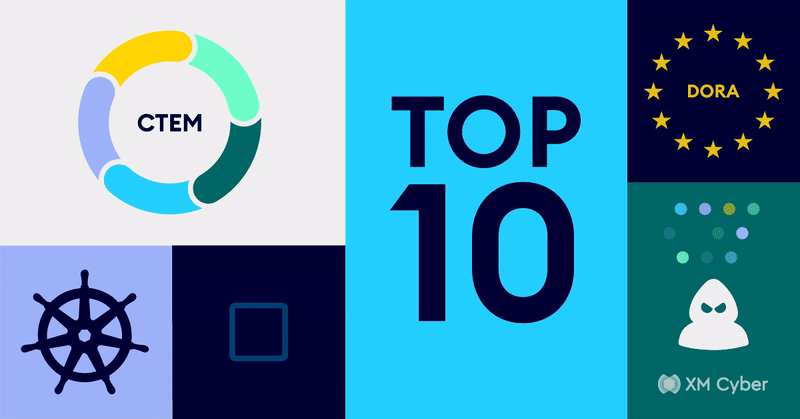|
Getting your Trinity Audio player ready...
|
Introduction
2025 is finally here!
And while not too many things in life are all that predictable, one thing that can be assumed with a strong degree of certainty is that expert prediction and trend roundups will abound. Especially in an ever-shifting field like cybersecurity where, to quote Ferris Bueller, “Life moves pretty fast. If you don’t stop and look around once in a while, you could miss it,” keeping an eye on the future helps to quickly anticipate changes. So in this very first blog of the new year, XM Cyber asked me to create a roundup of 10 Cybersecurity trends to watch in 2025 and give you practical tips on how to prepare for them so you too can stay resilient and future-focused.
This list is by no means definitive – any list of “issues that will make headlines in 2025” could go on and on for ages – this is simply what I see as most likely to be impactful for a wide group of security professionals. It’s a mix of some already known issues that will once again surface and some that are less widely talked about – and the unexpected is what makes our field both challenging and exciting. So, let’s look ahead. Here are my 10 cybersecurity trends I predict will define 2025 and how to prepare for them.
Trend 1: Continuous Threat Exposure Management (CTEM) – Outpacing the Enemy
For years, cybersecurity has been a numbers game. Teams focus on patching as many vulnerabilities as possible, working through overwhelming lists of threats ranked by severity scores. But threat actors don’t care about CVSS scores—they care about real-world opportunities. That’s why CTEM is such a game-changer. It focuses on how attackers would move through your system, prioritizing fixes that make the most significant impact.
How to Prepare:
- Use tools that simulate attack paths to visualize how threats might move through your network. It’s not just about what’s vulnerable—it’s about what’s exploitable.
- Break free from “quarterly snapshots.” Continuous assessment means always knowing your most pressing risks, not just the ones from last month.
- Shift your mindset to proactive defense. CTEM isn’t just about closing gaps; it’s about controlling the battlefield.
Trend 2: Strengthening Active Directory (AD) Security – Guarding the Crown Jewels
Active Directory is at the heart of enterprise networks. It’s where credentials, permissions, and access are managed. Unfortunately, it’s also one of the most commonly targeted systems. Threat actors exploit AD misconfigurations or stolen credentials to gain privileged access and use that as a launchpad for further attacks.
How to Prepare:
- Start with a total AD health check to identify misconfigurations, excessive privileges, and unused accounts.
- Automate routine audits to ensure AD complies with best practices—manual processes are too error-prone for such a critical system.
- Use breach simulation tools to test how AD weaknesses could be exploited and prioritize fixes accordingly.
Trend 3: Attack Graphs – Connecting the Dots Before Attackers Do
Attack graphs are like a GPS for threat actors—mapping the possible routes they could take to compromise your system. These dynamic visualizations show how various exposures connect, allowing defenders to see the complete attack chain rather than focusing on isolated risks.
How to Prepare:
- Use attack graph technology to understand how an attacker might move laterally through your environment.
- Prioritize fixes based on how much each action disrupts the attack chain—not just individual vulnerabilities.
- Build attack graph analysis into regular security reviews to stay ahead of evolving threats.
Trend 4: Operational Technology (OT) Security – Protecting What Keeps the Lights On
Critical infrastructure is under siege. From power grids to transportation systems, threat actors are increasingly targeting OT environments. Unlike IT systems, OT environments often operate on legacy hardware and software, making them uniquely vulnerable. A breach here doesn’t just cost money—it can put lives at risk.
How to Prepare:
- Conduct a comprehensive inventory of all OT assets. Many organizations don’t know the full scope of what they need to protect.
- Segment OT and IT networks to contain breaches and prevent attackers from hopping between environments.
- Train operational staff on cybersecurity best practices. Engineers, not cybersecurity professionals, often manage OT environments, and awareness is key.
Trend 5: Kubernetes Security – Taming the Cloud-Native Giant
Kubernetes is the backbone of modern cloud infrastructure, orchestrating containers that power everything from e-commerce platforms to financial services. Its flexibility is also its Achilles’ heel: misconfigurations, insecure APIs, and overly permissive settings are common pitfalls.
How to Prepare:
- Automate configuration management to enforce best practices and prevent human error.
Misconfigurations are one of the leading causes of Kubernetes vulnerabilities.
- Invest in runtime security to monitor activity inside containers. Real-time visibility is critical for detecting and responding to threats.
- Build security into the development process. Make Kubernetes security checks part of your CI/CD pipeline to catch problems before deployment.
Trend 6: Compliance with DORA and NIS 2 – Turning Mandates into Milestones
The Digital Operational Resilience Act (DORA) and the NIS 2 Directive represent a new era of cybersecurity regulations. These frameworks aim to create uniform standards for protecting critical industries, from financial services to healthcare. For these organizations, compliance isn’t optional—and failing to meet these standards can lead to hefty fines and damaged reputations.
How to Prepare:
- Treat compliance as an ongoing process. Regularly review your security posture to ensure it aligns with regulatory requirements.
- Use compliance tools to streamline reporting and reduce administrative overhead.
- Build a culture of resilience. Compliance frameworks often emphasize operational readiness and incident response—integrate these principles into your broader security strategy.
Trend 7: AI-Driven Threat Intelligence – Seeing the Unseen
Artificial intelligence is reshaping cybersecurity. AI-powered tools can analyze massive datasets, detect patterns, and predict potential threats with a speed and accuracy no human team could match. Threat actors are leveraging AI, too, so staying one step ahead is critical.
How to Prepare:
- Pair AI tools with high-quality threat intelligence feeds to improve detection and reduce false positives.
- Automate routine tasks like log analysis to free up your team for strategic efforts.
- Focus on predictive analytics. AI’s greatest strength isn’t just spotting existing threats—it’s anticipating future ones.
Trend 8: Zero Trust for Multi-Cloud Environments – Trust No One, Verify Always
Zero Trust is more than a buzzword—it’s the backbone of modern security strategies. In a multi-cloud world, where data moves freely between environments, assuming everything inside the perimeter is safe is no longer an option.
How to Prepare:
- Map your environment to understand where sensitive data lives and how it flows across systems.
- Enforce least-privilege access policies to limit exposure if credentials are compromised.
- Continuously monitor for unusual activity to detect and respond to threats early.
Trend 9: IoT Security – Securing the Web of Everything
From industrial sensors to smart doorbells, IoT devices are everywhere. But many were designed for convenience rather than security. A single compromised device can serve as an entry point into your broader network.
How to Prepare:
- Treat IoT devices as untrusted by default and segment them from critical systems.
- Regularly updating firmware to patch known vulnerabilities is a simple but often neglected step.
- Monitor device behavior for anomalies, as IoT devices are prime targets for botnet recruitment and other attacks.
Trend 10: Resilience by Design – Building Defense and Recovery into the Blueprint
Prevention alone isn’t enough—resilient organizations bake security and recovery into their systems. By embedding defense mechanisms and planning for incidents ahead of time, businesses can adapt, recover quickly, and keep moving forward when cyber threats strike.
How to Prepare:
- Regularly test incident response and recovery plans through simulated attack scenarios.
- Train developers in secure coding practices and conduct threat modeling during the design phase.
- Make security testing part of your continuous development process to catch issues before deployment.
Conclusion
Some cybersecurity challenges in 2025 will feel like déjà vu—issues like securing AD or building resilience are as familiar as they are persistent. Others, like defending Kubernetes or tackling AI-enhanced threats, require new approaches.
The one constant is preparation. By addressing the old and the new with innovative tools and strategies, you can stay ahead of malicious actors and turn cybersecurity into a competitive advantage.





